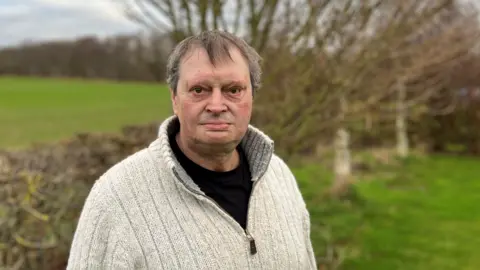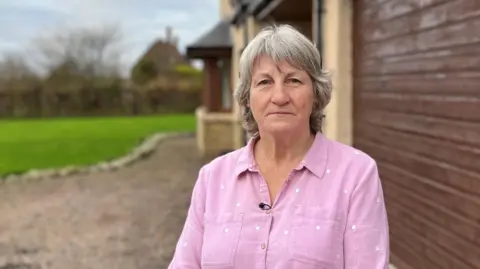Bu içerik, İskoçya’da bir köy olan Leitholm’daki enerji depolama tesislerine karşı verilen mücadeleyi konu almaktadır. Köy sakinleri, önerilen pil depolama tesislerinin köylerine zarar verdiğini ve tarım arazilerinin betonla kaplandığını iddia etmektedir. Enerji uzmanları, İskoçya ve Birleşik Krallık’ın net sıfır hedeflerine ulaşmasında enerji depolamanın önemli bir rol oynadığını belirtmektedir. Ancak, bu tesislerin diğer çevresel endişelerin önüne geçmemesi gerektiğini vurgulamaktadır. Köy sakinleri, tesislerin ev fiyatlarını düşürdüğünü ve yaşamlarını olumsuz etkilediğini iddia etmektedir. Yerel topluluk konseyi, köy sakinlerinin endişelerini desteklemekte ve enerji tesislerine karşı mücadele etmektedir.
[ad 1]
Kaynak: www.bbc.com

 BBC
BBCA rural community in the Borders is warning that Scotland’s renewable energy revolution is coming at a cost.
Residents of Leitholm – a village between Coldstream and Greenlaw – claim the heart is being ripped out of their community with the arrival of battery storage facilities.
If all six proposed facilities are approved, more than 200 acres of farmland will be turned over to concreted compounds within a three-kilometre radius of their village.
Retired nursery owner Seonaid Blackie said: “This is not the place it used to be – people are worried sick.”

 REUTERS/Adrees Latif
REUTERS/Adrees LatifScottish Power Energy Networks (SPEN) are currently expanding and creating new electricity substations across central and southern Scotland to cater for the increase in renewable energy being generated, mainly by onshore and offshore windfarms.
With the National Grid predicting that the amount of energy storage will need to increase by six times before the end of the decade, bids for new battery compounds are following behind each substation development.
The facilities will be required to store excess energy, which will then be released when there is less wind or demand increases.
As work to double the size of the Eccles substation, close to Leitholm, continues permission has been granted for two battery storage facilities on nearby farmland – with a further four in the pipeline.
Eccles Energy Centre Limited, which has submitted plans for a 500MW facility around two kilometres south of Leithholm, says there are significant restrictions to where battery developments can currently be connected to the network.
A spokesperson explained: “Connection capacity currently exists at expanded or newly developed strategic substations in the Scottish Borders and this is why we are working to develop, construct and operate a battery energy storage system in immediate proximity to the Eccles HV substation.
“Our site has also been selected with the view of minimising impact on environment, infrastructure, traffic and local communities, and the development will adhere to all local and national planning, and environmental requirements.”


Richard Honer relocated to the Berwickshire village almost two decades ago after suffering severe injuries in a car crash.
The electrical engineer spent six months in a burns unit fighting for his life.
He believes the peaceful Leitholm countryside has been crucial for his rehabilitation.
But one of the proposed storage facilities is earmarked for the arable fields behind his home.
Richard said: “I suffer from tinnitus and the noise from this will be horrendous.
“I came here after my accident and it has has been such a great place for the recovery of both my physical and mental health.
“The view from my windows is currently green fields, but it will soon be concrete with around 250 individual container units.
“I feel the heart is being ripped out of this beautiful place that I call home.”


Industry expert Professor John Irvine, from St Andrew’s University, believes energy storage has a vital role to play in both Scotland and the UK reaching net-zero targets.
But he feels they should not be at the expense of other environmental concerns.
He said: “We need energy storage – about half of our electricity at the moment is coming from wind.
“To get all of our electricity from renewables we need storage – and batteries are an important part of solving some of the problems that come with this aim.
“But having food production and carbon capture are also very important – there needs to be a balance.
“Industrial brownfield sites should be the place to start when considering battery storage facilities.
“You need controls to make sure you have enough energy storage, but also to make sure that you don’t have too much.”


Seonaid Blackie recently bought her retirement bungalow in the nearby town of Kelso.
But the sale of her family home of the past 16 years, outside Leitholm, fell through on the day it was to be signed over – after the buyers found out about plans for two battery storage facilities within a mile of her front door.
The former nursery business owner said: “We had worked all of our lives so we could have a comfortable retirement, but that has been taken away from us.
“My husband is unable to give up work as we are now having to pay for two houses.
“I have lived around here for 40 years and we had such a lovely community – but everything is changing.
“The community has been divided by this, and what is currently countryside will soon be an industrial estate.”


Approval for battery energy storage facilities is decided, depending on their size, by either the local authority or the Scottish government’s Energy Consents Unit (ECU).
The Scottish government says that impacts on communities are a consideration under their Fourth National Planning Framework (NPF4).
They also state that cumulative impacts are also taken into account as part of the decision-making process.
The spokesperson added: “All applications are subject to site specific assessments.”
Scottish Borders Council says that all parties have their opportunity to comment directly on applications which either go before them, if below 50MW, or to the ECU.
A spokesman said: “The council’s remit is to assess the planning implications of the proposal – in other words, to assess the proposal against development plan policies and make any technical assessments that it has responsibility for, such as landscape and visual impacts, access, noise and the effect of these on residential amenity.”


SPEN are currently consulting with two other communities in the Scottish Borders – near Hawick and Lauder – about the creation of two new substations as part of their Cross Border Connection Project.
The company said: “The substation at Eccles is a critical point of the electricity grid and is being extended to install equipment that will facilitate the transfer of power between Scotland and England to meet this increase in demand and renewable generation.”
But resident James Finnie believes one of the proposed battery storage facilities near Eccles substation has put his life in limbo.
He explained: “Both my wife and I have elderly parents in their 80s and 90s – and we decided a couple of years ago to sell up and move closer so that we could take care of them.
“We put our home outside Leitholm on the market, but during the sales process the news came through the grapevine about a battery storage site being planned directly behind our home.
“Since making this known on our sellers’ declaration there has been absolutely no interest – our selling agent has advised that there will need to be a 40 percent reduction in the sale price.
“We feel that our lives are now on hold.”


Leitholm, Eccles and Birgham community council supported the substation extension, as well as the initial two battery storage facilities.
They are now leading a fight against the further four applications.
Chair Bob Hope said: “Most people are supportive of the transition to renewable energy but they are not supportive of it being left to market forces rather than a strategic approach.
“Every part of Scotland could be affected by these developments.”







Yorumlar kapalı.